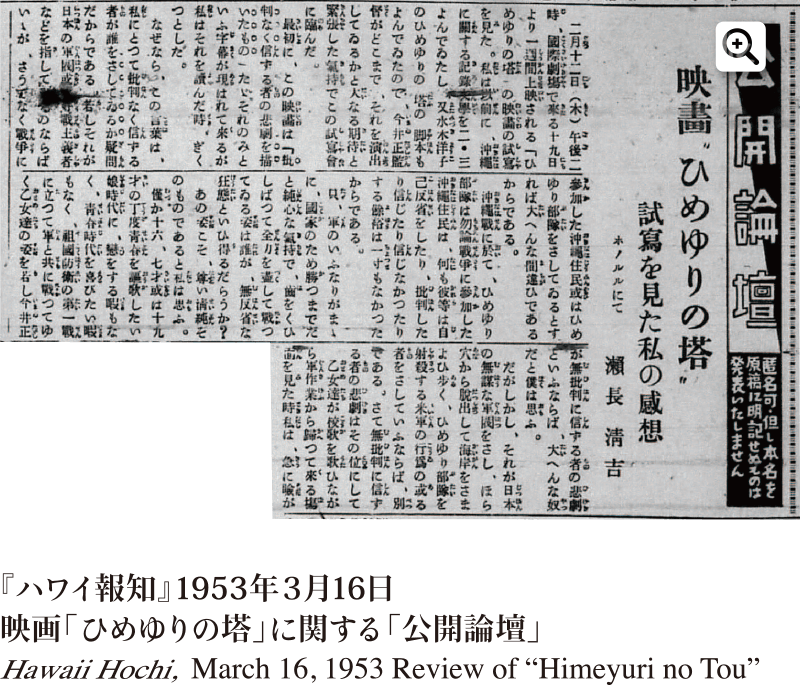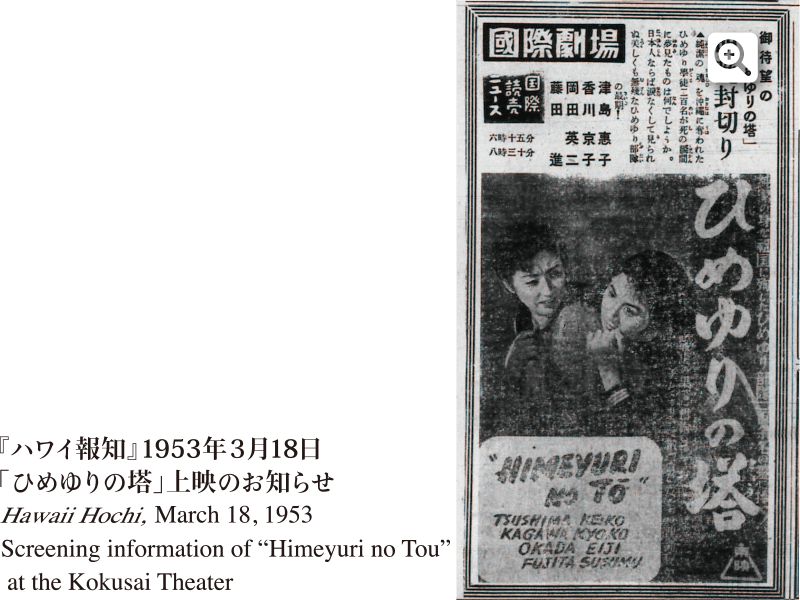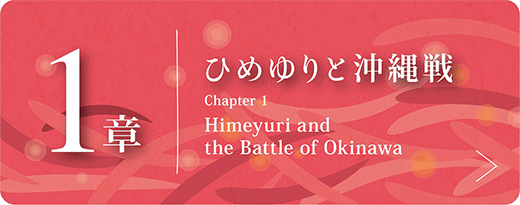ひめゆり学徒隊の引率教師で、伊原第三外科壕(ひめゆりの塔が立っている壕)で亡くなった親泊千代子先生は、ハワイ生まれでした。戦後、荒れ果てたひめゆりの塔周辺を整備し、敷地の購入資金を寄付したのは沖縄系ハワイ二世のハリー・儀間真一さんでした。戦後、ハワイ二世と結婚し、ハワイに移住したひめゆりの同窓生もいます。
第二章では、ひめゆりとハワイとのつながりをめぐるストーリーを紹介します。
Himeyuri teacher, Chiyoko Oyadomari, who died in the Ihara Third Surgical Cave (where the Himeyuri Cenotaph now stands), was born in Hawaiʻi. After the war, Hawaiʻi-born nisei (second generation Japanese American) Harry Shinichi Gima maintained the grounds around the remote cenotaph and donated the funds needed to purchase the site. In addition, many former Himeyuri students would eventually settle in Hawaiʻi after marrying Hawaiʻi-born men.
In Chapter 2, we will begin the story of the Himeyuri-Hawaiʻi connection.

ハリー・儀間真一さんが撮影したひめゆりの塔/ Himeyuri Cenotaph photographed by Harry Shinichi Gima
ハワイに渡った
うちなーんちゅUchinanchu emigration to Hawaiʻi
沖縄からの海外移民は、1899年、ハワイへ渡った26人をもって始まります。移民した大半の理由は、貧困からの脱却にありましたが、中には徴兵を逃れるために移民したという人もいます。移民先は、ハワイから、北米、南米、南洋諸島へと広がっていきました。戦前、約2万人が沖縄からハワイへ移住しました。その多くがサトウキビ農地で働きました。低賃金の長時間労働という過酷な状況に耐えながら、お金を貯め、沖縄にいる家族に送りました。
In 1899, the first wave of 26 Okinawan immigrants arrived in Hawaiʻi. Their reasons for leaving Okinawa varied; many left to escape poverty while others left to avoid being drafted into the military. Beginning with Hawaiʻi, Okinawan emigration would spread to both North and South America and to the South Seas. By the start of the war, about 20,000 people from Okinawa had made Hawaiʻi their home. Many labored at sugarcane plantations, enduring rough conditions, long hours and low wages in order to save money and support their families in Okinawa.

ひめゆり学徒隊の引率教師
親泊 千代子先生Himeyuri teacher Chiyoko Oyadomari
親泊千代子は、1922年、ハワイで生まれました。千代子の父、親泊元正は、プランテーションに入った後、独立し、魚の卸売等をしながら暮らしをたてていましたが、1930年、千代子が8歳のとき、家族で沖縄に引き上げてきました。帰国後、元正は、那覇市に「親泊元正商店」を設立します。千代子は、那覇市立甲辰尋常小学校2年生に転入します。ハワイでは飛び級で、3年生になっていた千代子は、悔しがりました。2年生への転入は、言葉の問題を考慮したことによるものでしたが、千代子は、言葉の問題など苦ともせず、持ち前の優秀さを発揮し、県立第一高等女学校に進学します。1940年には、女子教育では最高学府といわれた東京女子高等師範学校(現お茶の水女子大)に入学。43年に卒業し、母校・沖縄県立第一高等女学校の教師になりました。

一高女卒の先輩であり、明るく、都会的な話し方をする千代子は、生徒たちの憧れの的でした。千代子の授業は、教科だけにとどまらず、自由で楽しい雰囲気に満ちたものでした。生徒から歌のリクエストがあると、アルトのきれいな声で「お菓子と娘」を歌いました。寮の舎監でもあった千代子は、寮生からお姉さんのように慕われました。沖縄戦が濃厚となり、多くの女教師が疎開する中、千代子は、沖縄に留まり最後まで生徒と行動を共にすることになります。
戦場では、勤務で疲れた生徒たちを歌で励まし、南下の際には、脳症のため自力で行動できない生徒の面倒をみました。親泊千代子は、ひめゆりの塔の建つ伊原第三外科壕で米軍の攻撃により命を落としました。23歳でした。
Chiyoko Oyadomari was born on a plantation in Hawaiʻi in 1922, where her father, Gensei Oyadomari worked as a laborer. After a time, Gensei left his plantation job and opened a wholesale fish business. In 1930, when Chiyoko was eight years old, she was brought back to live with her family in Okinawa.
Upon the family’s return to Japan, the Oyadomari Gensei Store was established in Naha City. As she was thought to have language challenges, Chiyoko had to enter the second grade at the Naha City Koshin Elementary School (she had been in third grade in Hawaiʻi) but, because of her natural intelligence, she would go on to the Okinawa First Girls’ High School and, eventually, the Tokyo Women’s Higher Normal School (now, Ochanomizu University) – one of the top schools for women in Japan. After graduating in 1943, Chiyoko returned to Okinawa as a teacher at her alma mater, the Okinawa First Girls’ High School.
Her history with the school and her bright and lively teaching style made her the idol of her students. She taught her subjects in an open atmosphere that brought joy to the classroom. When requested, she would sing songs, such as “Okashi to Musume” in her beautiful alto.
As director of the dormitory, Chiyoko was also the beloved elder sister to all student residents.
As the Battle of Okinawa intensified and many of the other teachers evacuated, Chiyoko chose to stay with her students in Okinawa to the end.
As the battle raged, she would lift her tired students’ spirits with songs and, during the trek southward, she cared for students sick with encephalopathy who could not care for themselves.
Chiyoko Oyadomari was killed at the Ihara Third Surgical Cave – the site of the Himeyuri Cenotaph – when American forces overran the facility. She was 23 years old.

砲声のとどろく中、壕掘り作業をつづけましたが、ここでの食事は、1日1食、それもおにぎりが1個だけでした。はじめは張り切っていた私たち生徒も、急速に疲労が深まっていきました。休憩時間、私たちが狭い壕の中で膝をかかえ、ぴったり寄り添ってすわっていると、突然、きれいなアルトの歌声が聞こえてきました。親泊先生の歌声でした。「お菓子の好きなパリ娘 二人そろえばいそいそと 角の菓子屋へボンジュール」歌が終わると、じっと聞き入っていた生徒たちの中からいっせいに拍手が起こりました。落ち込んでゆく生徒たちの気持ちを少しでも引き立てようとする親泊先生のあたたかい思いやりが生徒たちの胸の内側にしみじみと伝わっていくようでした。
宮城喜久子『ひめゆりの少女・十六歳の戦場』
“While the sound of battle roared, we had to continuously dig trenches even though our one daily meal was a single rice ball. Students who were enthusiastic at the start quickly became tired. During one break as we knelt close together, we heard the sound of Miss Oyadomari’s beautiful voice. When the last lines of the song, ‘…two Parisian girls enjoy sweets at the corner candy shop, bonjour!’ all of us listening burst into applause. Miss Oyadomari’s efforts to raise students’ spirits went straight to our hearts.”
—Kikuko Miyagi
FromA 16 year-old Himeyuri on the Battlefield
日本とハワイでの「ひめゆり」ブームThe “Himeyuri boom” in Japan and Hawaiʻi
戦後、日本ではひめゆり学徒隊を題材とした小説や映画が一大ブームとなりました。そのブームは、海を超え、ハワイにまで広がりました。大ヒットした映画「ひめゆりの塔」がハワイの国際劇場で上映され、話題となったことが、当時の新聞記事から分かります。ハワイでは、映画に登場する宮城先生のモデルがハワイ出身の親泊千代子であることがわかり、注目されました。
In the aftermath of the war, books and movies about the Himeyuri were very popular in Japan. This “Himeyuri boom” would reach across the sea to Hawaiʻi.
An article in a local newspaper from that time, announcing the showing of the hit movie, Himeyuri no Tou (“The Himeyuri Cenotaph”) at Honolulu’s Kokusai Theater still remains.
In Hawaiʻi, the discovery that the character of Miss Miyagi was modeled after Hawaiʻi-born Chiyoko Oyadomari gained much attention.









